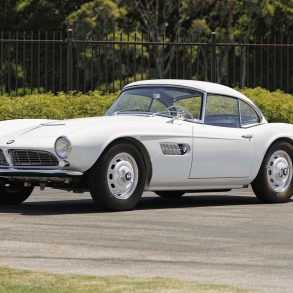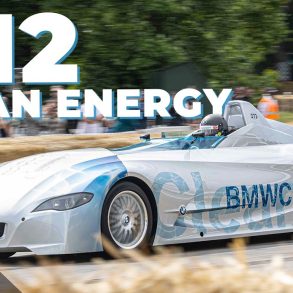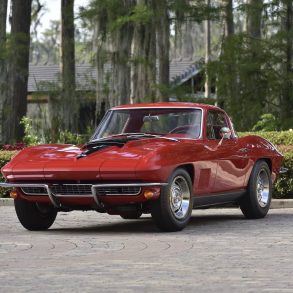By Will Silk

While the BMW 507 may be viewed as a contemporary German masterpiece by some, it was actually much more American in spirit than many will give credit for. The early 1950s were a struggling time for much of the world, as many nations were still rebounding from the effects of World War II. Germany was certainly one of these nations, and BMW was a name still perhaps known more only on the Continent for building fine cars than across the Atlantic in America. However, the leadership at BMW wished to change that due to the large consumer market for luxury automobiles and sports cars in the United States that emerged after war. With the venerable 2-liter inline six being picked up by Bristol as part of a war reparations deal, and with the styling of the post war BMW 501 not going over well in the United States; BMW was desperately looking for a new product to market in America that would win over the performance minded enthusiast.
Max Hoffman was the leading importer in the U.S. then, and he insisted that BMW build a car that could compete with the Mercedes 300SL. That’s when the Bavarian auto maker turned to a German designer living in America by the name of Al Goertz. Goertz was born into a noble German family near Hanover, Germany and was provided the best education, which eventually saw Al enter his family’s banking firm and sent to England to start his career abroad. Prior to the outbreak of the Second World War, Goertz made the hop to America, where he became disconnected from his family due to the war. He turned to the hobby he loved, that of sports cars, and became a mechanic before enrolling in the Pratt Institute to study design. Goertz graduated and eventually found work with none other than Raymond Loewy, one of America’s most famous designers of the 20th century. While working under Loewy, Al was included on the design campaigns for the 1950-1953 Studebakers.
BMW contacted Goertz and asked if he would take on a task to solely design their new sports car. While Goertz had set about designing the car as a whole, the team in the powertrain department had worked up an engine that would have looked just at home under the hood of one of Detroit’s iron sleds of the day. The engine was a 90 degree aluminum alloy V8 with push rod actuated valve train and displaced 193 cubic inches, or 3.2 liters. Two Zenith 32 NDIX down draft carburetors which provided the air and fuel mixture to the German V8 were mounted between the rocker covers of what was Europe’s only large production V8 engine of the time. Power was rated at 173 SAE horsepower at 5,000 rpm in a test performed by Sports Car Illustrated in December of 1959.
Backing the potent little V8 was a close ratio four speed transmission which shot the power back to the live rear axle which BMW offered in three ratios; a 3.90, 3.70, or a 3.42 to one. Initially, brakes were Alfin drum units at all four corners, however later cars were fitted Dunlop discs on the front end. Front suspension on the 507 was independent via dual wishbones and topped off with an anti-roll bar, and shocks were either F&S or Koni products. Tires were of 6.0 by 16-inch in size.
With Goertz having penned out the exterior and interior designs, the BMW 507 went into production, amazingly with a body that was virtually all-aluminum. Designed from the outset as a road going machine, the company paid close attention to all the details going into the build of what was to be the halo car for the marque in the mid-50s. The numbers in terms of performance were good for the roadster from Munich, as the extensive use of aluminum saw the car weigh in at 2840 pounds with a full tank of fuel. Zero to sixty was accomplished in roughly 9 to 10 seconds which was quite brisk in the day, and the quarter mile would pass by in sub-18 seconds.
While the craftsmanship was second to none, and the performance was fairly good, the price tag was anything but. Max Hoffman was intent on selling the BMW 507 for the around $5,000. However, the price soared to nearly twice that upon the first customer taking delivery of the sports car in 1956. By 1959, when our featured car was built, the price had climbed out a little more to just over $11,000. In the end, around 250 units were constructed between 1956 and 1959, making the BMW 507 one of the rarer road going sports car collectibles from that time period.
Today, despite carrying the ominous reputation as being the car that took BMW over the edge and into bankruptcy in 1959, the 507 has maintained its presence in the collector car realm and the prices clearly reflect the desirability to own one of BMW’s best cars. The $18,500 price requested in the 1978 ad, though a great deal of money at the time, would seem like pennies today, as when these classic aluminum beauties emerge onto the market the prices frequently hover between $500,000 and $1,000,000. Truly, one must take into account the rarity and of course the beauty of the BMW 507 when considering the value of what many say is the most beautiful car the marque has ever built.
[Source: Hemmings]
BMW 507 – Classic Cars for Sale
3 Comments
Leave a Reply Cancel reply
You must be logged in to post a comment.










A PFC in my US Army company in Germany in 1976-77 owned a BMW 507.
If he’d kept it . . .
If I’d bought it from him (for peanuts) . . .
I missed the Shah’s BMW 507 in excellent condition at a used car dealer when I moved to Phoenix in 1970. The dealer was willing to trade even for our family car, a 1968 MB without A/C, but my wife at that time insisted she couldn’t drive it, especially with our newborn baby. Three years later I traded an old Land Rover and $1000 for a Ferrari LWB California; you never know!
I remember 1987 being the year these cars really started appreciating. I remember in early spring that year Jack Frasher, an infamous BMW collector in SC, was offering one. He must’ve had at least four 507’s in his showroom at some point in the mid 80s. I remember him selling 2 in 1986, one for $43k and one for $50k. Another one sold at an auction in ’86 for $70k, but it had a one-off Vignale body (chassis #184), hence its higher price.
I think the exact month was April 87, and he was offering one thru a client of his for $55k.
I remember finally getting around to making an inquiry in October, it was the week before the market crash. I was told that the first one had since sold, but he had another one in similar condition for $77500. It was unbelievable how fast they were rising. Keep in mind that the Ferrari craze was already well in effect, but I thought it hadn’t spread to German touring cars yet.
I wasn’t ready to shell out $77k for the car yet, so I decided to take a pass, and prices only continued to climb from there. That same month one sold at an auction in France for around $95k US. In May ’88 at a Geneva auction another went for around $170k US. In 1989 they were in the $300k range. I knew at that point the 507 would never be mine.
Don’t even talk to me about the beautiful red series I 507 I had offered to me in the Summer of ’74 for $6500.
Jon